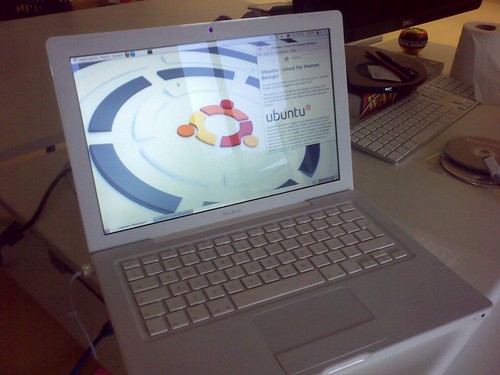Feast your eyes on this:
No, it's not photoshopped. What you see is indeed one of Torchbox's white Macbooks, running Ubuntu "Lucid Lynx" Linux. A few years ago, when I was looking for a new work laptop, Tom suggested in a moment of madness that I could get a Mac and run Linux on it. At the time I thought it was the silliest thing I'd heard of. Imagine!
Fast forward two and a half years, and the enormous Dell brick that I bought has started to become more of an annoyance than anything else - too big, too heavy, built-in mouse's buttons broken, battery frequently flickers down to 50% capacity - and it's time to decide whether I want to switch to another existing office laptop before some of our new hires arrive. That idea of Tom's (yes, Tom, if Stewart asks then it's your idea) strikes me again. Could it be possible?
In the end, it was almost ridiculously easy: after a fair bit of hassle resizing partitions; I managed to find relevant documentation online; the Ubuntu 64-bit Lucid Lynx "Live CD" booted the machine straight away so I could confirm (a) it worked and (b) the things nobody expected to work, didn't work; the install sequence took about ten minutes; and the solutions to post-install issues were exactly as documented.
There were only two major problems that dogged me much of the way. Each of them is somewhat stereotypical of the respective community or technology involved:
- As mentioned above, OSX/Boot Camp steadfastly refused to change partition sizes on the machine. A graphical interface took me through some cute wizard with progress bars, then summarily told me I'd have to back up the machine and reinstall OSX. Then the OSX install disks said that I couldn't install OSX on this machine. What they both should have said was "Use GParted: it might not be as pretty as they make Mac apps, but you'll be able to work your way through using granular controls we won't let you touch." This is evidence of the standard internet trope OSX as a tamper-proof sealed unit.
- Ubuntu's documentation is an absolute rat's nest. I can't even find the comparison matrix of Macbook and Macbook Pro machine types that leads you off into the relevant documentation pages. What I can tell you is that you'll need the catchily named "MactelSupportTeamAppleIntelInstallation" for most of your initial setup and installation, and "MacBookPro" for Macbook Pros or, er, "MacBook" for Macbooks, or Mac Books as the wiki would have them. This is evidence of the standard internet trope Linux as an unnavigably documented hobbyist's pursuit.
But really, if I were to make too much of either of those problems in this context then it would be cavilling. Partition resizing is easy to get horribly wrong; and that ridiculously complete level of documentation didn't even exist two years ago.
This has been a trial installation really, as I hope to eventually get a hand-me-down Macbook Pro to run it on. But this finished article has functioning wifi and a working webcam (both of which are proprietary monsters), great sound and the most beautiful DVI-powered second display I have ever seen. After coding on two huge LCD displays for nearly two years, I would still gladly switch to a wee Macbook monitor, typically closed and connected to just one of those large LCD displays. DVI seems to make all the difference over VGA, although I would have never believed it.
Now, of course, I want a Macbook for home use. Running Linux, of course: but maybe this was Tom's idea all along. Mactel Linux as a gateway drug. I can hold out, though; at least, I can wait for them to sort out package management first.

